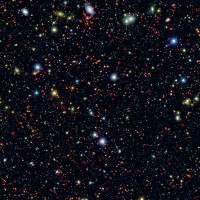Scientists “fish” for galaxies in this playful, digitally altered photo. The researchers are part of a program called SPLASH, which is using NASA’s Spitzer Space Telescope to dive deep into the cosmic sea and find some of the most remote galaxies known. Early results are turning up surprisingly big “fish” — massive galaxies — in the darkest reaches of the universe, dating back to a time when our universe was less than one billion years old. (NASA/JPL-Caltech)
Home Scientists “fish” for galaxies in this playful, digitally altered photo. The researchers are part of a program called SPLASH, which is using NASA’s Spitzer Space Telescope to dive deep into the cosmic sea and find some of the most remote galaxies known. Early results are turning up surprisingly big “fish” — massive galaxies — in the darkest reaches of the universe, dating back to a time when our universe was less than one billion years old. (NASA/JPL-Caltech) Scientists "fish" for galaxies in this playful, digitally altered photo. The researchers are part of a program called SPLASH, which is using NASA's Spitzer Space Telescope to dive deep into the cosmic sea and find some of the most remote galaxies known. Early results are turning up surprisingly big "fish" -- massive galaxies -- in the darkest reaches of the universe, dating back to a time when our universe was less than one billion years old. (NASA/JPL-Caltech)
Scientists “fish” for galaxies in this playful, digitally altered photo. The researchers are part of a program called SPLASH, which is using NASA’s Spitzer Space Telescope to dive deep into the cosmic sea and find some of the most remote galaxies known. Early results are turning up surprisingly big “fish” — massive galaxies — in the darkest reaches of the universe, dating back to a time when our universe was less than one billion years old. (NASA/JPL-Caltech)



